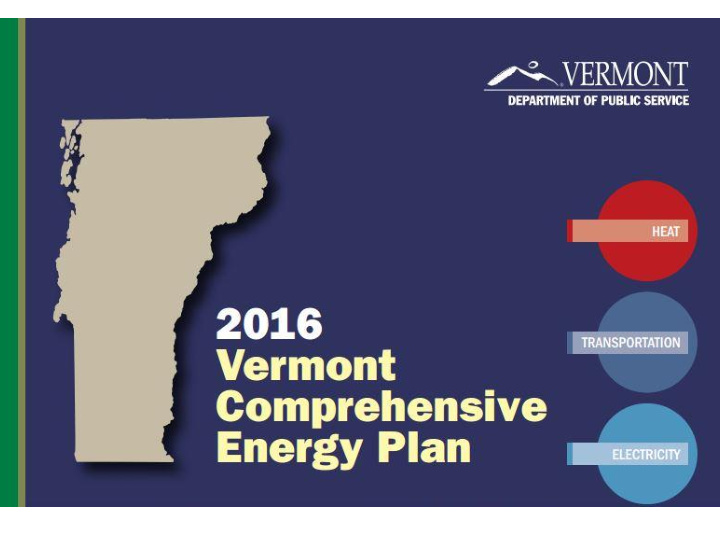



Major themes • Clean energy jobs • Affordable and stable energy supply • Retain our energy dollars • Stable and low electric rates • Focus on most vulnerable Vermonters • Low-income efficiency and weatherization programs • Heat saver loan and other financing options Codes and standards • 2
Goals in Statute • Meet energy needs in a reliable, secure, sustainable, and affordable manner. (30 V.S.A. § 202a) • Renewable policies that promote economic benefit, efficient use of resources, stable prices, market development, air and water quality, grid stability, climate change mitigation, and diversity of resources. (30 V.S.A. § 8001) • 25% renewable by 2025. (10 V.S.A. § 580(a)) • 50% GHG emission reduction by 2028, and 75% (if practicable) by 2050. (10 V.S.A. § 578(a)) • Building efficiency – weatherize 25% of housing stock by 2025. (10 VSA. § 581) 3
Requirements in Statute • Renewable Energy Standard will grow the share of renewable energy in Vermont’s portfolio through market - based mechanism (renewable energy credits). (30 V.S.A. § 8005) – 55% renewable in 2017, rising 4% every three years to 75% in 2032; and – 1% from distributed generators connected to Vermont’s electric grid in 2017, rising 0.6% per year, to 10% in 2032. – Energy transformation projects will reduce fossil fuel use. Equivalent of 2% of retail sales, escalating to 12% in 2032. • Standard Offer Program provides for long-term contracts for resources that are 2.2 MW or less (up to 127.5 MW). (30 V.S.A. § 8005a) 4
Illustrative Pathways • The CEP presents some “illustrative” pathways to achieve 90 percent renewable by 2050. • These are based on the best available information as of when the CEP was written, but technology, costs, concerns, and markets will inevitably take unexpected turns. • The state should remain nimble in our approach to reaching our goal. (e.g. solar costs) 5
Energy Austerity? Will efficiency negatively impact economic growth? Modeling takes into account population and economic growth on par with historic levels. “A reduction in consumption on this scale does not imply a regime of energy austerity or any restriction on growth in manufacturing output. It is possible to provide an increased level of energy service, compared with Vermont today, with signi gnific icantly antly less ss waste .” (Page 35 of the Comprehensive Energy Plan) 6
Efficiency – 3 ways Continuing improvemen ements ts in thermal ermal and electric ctric end-use use • efficien iency . “Bread and butter” efficiency in electric use continues at current scale. • Fuel switching away from combustion technologies to more efficien ient t electric ctric-powere ered d technologies hnologies. Electric technologies are 2 to 3 times more efficient than combustion. (Electric vehicles and heat pumps). • Move away from fossil electric generators, which are inefficient to renewable ble generat erator ors. 7
Heat - 2025 • 25% of older non-industrial buildings weatherized. • 25% of non-industrial buildings rely primarily on heat pumps. • Amounts to an average heating load of ~66 million Btu per capita • ~10% reduction on per capita basis 8
Transportation - 2025 • 20% of Light Duty – Electric • ~51 million Btu per capita • ~10% reduction on per capita basis 9
Electric Power Goal: 67% renewable by 2025 Electrifying heat and transport will increase electric energy demand: • Load control on new electric demand is key. • Storage, demand response, and smart rates will play a more important role. 10
For more information on the energy plan go to: http://energyplan.vt.gov Joan White Department of Public Service joanna.white@vermont.gov 802-828-0554 11
Recommend
More recommend